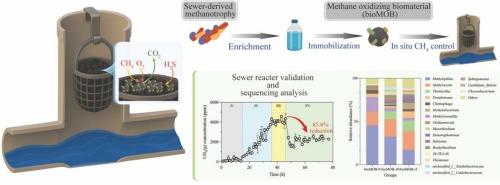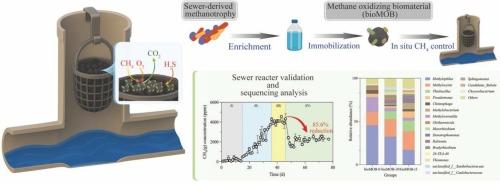污水源好氧甲烷氧化菌的富集及应用以提高污水中气态甲烷的去除
IF 9.7
1区 环境科学与生态学
Q1 ENVIRONMENTAL SCIENCES
引用次数: 0
摘要
下水道系统的甲烷排放一直是一个双重环境威胁,既有爆炸风险,又有强烈的温室气体影响。目前的甲烷去除策略主要针对生物膜和废水阶段的化学剂量;然而,微生物的适应和波动的水质往往降低控制效率,产生高昂的化学品成本。在这里,我们提出并展示了一种新的微生物方法,利用好氧甲烷氧化菌直接氧化气态甲烷。污水微生物具有较高的甲烷氧化能力,可达0.30 μmol/(h·g)。污水源甲烷氧化菌富集成功,甲烷氧化率达到200 mg CH4/(g DCW·d)以上。利用富集的好氧甲烷氧化菌,开发了一种创新的原位气态甲烷控制策略。污水反应器经长时间运行后,甲烷排放量减少85.6% %,采用简单灵活的再活化处理可恢复微生物活性。值得注意的是,由于生物炭介导的吸附和随后的化学岩石营养氧化,该反应器可以消除硫化氢,这证明了混合系统的多功能性。高通量测序和宏基因组测序进一步显示,Methylocystis(相对丰度为15 %-20 %)和Methylophilus(相对丰度为17 %-46 %)是下水道系统中具有显著碳减排潜力的核心功能物种。这些结果可以证明一种既经济又环保的解决方案,可以去除下水道中的气态甲烷和硫化氢。本文章由计算机程序翻译,如有差异,请以英文原文为准。


Enrichment and application of sewer-derived aerobic methanotrophs to enhance gaseous methane removal in sewers
Methane emission from sewer systems persists as a dual environmental threat, combining explosion risks with potent greenhouse gas impacts. Current methane removal strategies have primarily targeted biofilm and wastewater phases by chemical dosing; however, microbial adaptation and fluctuating water quality often reduce the control efficiency, incurring high chemical costs. Here we propose and demonstrate a novel microbial approach that utilizes aerobic methanotrophs for direct gaseous methane oxidation. Sewer-derived microbes was discovered to exhibit a high methane oxidation capacity of 0.30 μmol/(h·g). The sewer-derived methanotrophs were then successfully enriched, with a high methane oxidation rate of more than 200 mg CH4/(g DCW·d). Leveraging the enriched aerobic methanotrophs, an innovative in-situ gaseous methane control strategy was developed. Methane emission reduction reached 85.6 % in a sewer reactor under prolonged operation, and microbial activity could be restored following easy and flexible reactivation treatment. Notably, hydrogen sulfide could be eliminated in this reactor, attributed to biochar-mediated adsorption and subsequent chemolithotrophic oxidation, which demonstrates the multifunctionality of the hybrid system. High-throughput sequencing and metagenomic sequencing further revealed Methylocystis (15 %-20 % relative abundance) and Methylophilus (17 %-46 % relative abundance) as core functional species that exhibit significant potential for carbon emission reduction in sewer systems. These results can demonstrate an economical and environmentally friendly solution to both gaseous methane and hydrogen sulfide removal in sewers.
求助全文
通过发布文献求助,成功后即可免费获取论文全文。
去求助
来源期刊

Environment International
环境科学-环境科学
CiteScore
21.90
自引率
3.40%
发文量
734
审稿时长
2.8 months
期刊介绍:
Environmental Health publishes manuscripts focusing on critical aspects of environmental and occupational medicine, including studies in toxicology and epidemiology, to illuminate the human health implications of exposure to environmental hazards. The journal adopts an open-access model and practices open peer review.
It caters to scientists and practitioners across all environmental science domains, directly or indirectly impacting human health and well-being. With a commitment to enhancing the prevention of environmentally-related health risks, Environmental Health serves as a public health journal for the community and scientists engaged in matters of public health significance concerning the environment.
 求助内容:
求助内容: 应助结果提醒方式:
应助结果提醒方式:


